Top 8 ⛩️ Shrines and Temples to Visit in Tokyo and Kyoto
The 8 Most Exciting Shrines and Temples to Explore in Japan!
Planning a trip to Japan? Want to soak in some of the Shinto and Buddhist religion and explore historical sites?
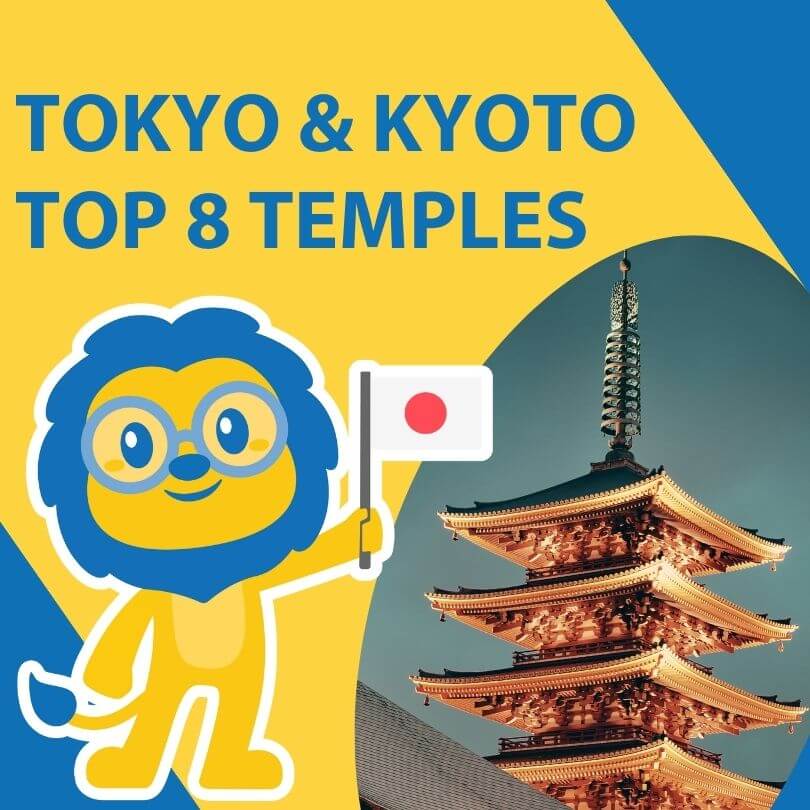
If so, this is the article for you!
We’ve collected the top 8 shrines and temples to visit in the two cities.
In addition, we’ve made a list of the words to know when visiting temples and shrines in order to get a bit more out of your visit and observe some of the local customs.
Let’s get to it!
Shrines and Temples in Tokyo | Ueno Tosho Shrine (上野東照宮)
Shrines and Temples in Tokyo | Sensōji Temple (浅草寺)
Shrines and Temples in Tokyo | Meiji Jingu Shrine (明治神宮)
Shrines and Temples in Kyoto | Kinkakuji (金閣寺)
Shrines and Temples in Kyoto | Fushimi Inari Shrine (伏見稲荷大社)
Shrines and Temples in Kyoto | Tōji Temple (東寺)
Shrines and Temples in Kyoto | Sanjūsangen-dō (三十三間堂)
Shrines and Temples in Kyoto | Shinnyodō // 真如堂
Shrines and Temples | Essential Vocabulary
Tokyo Temples
Ueno Toshogu Shrine // 上野東照宮
Located in Tokyo’s Ueno Park, the Ueno Toshogu Shrine is right next to the Ueno Zoo. It dates from 1627 and was dedicated to Tokugawa Ieyasu, the famous warlord who served under Oda Nobunaga.
It has beautiful gold leaf architecture, including the karamon (pictured on the right), a type of gate used in Japanese architecture, and the honden, or main building of the shrine.

In addition to the shrine’s buildings, it also has a lovely peony garden if you visit in May!
If you want to make a day out of it, I also recommend visiting the Tokyo National Museum, which is a 5-minute walk from the shrine, and perhaps the zoo if you have young children.

Discover Tokyo // A Beginners Guide to Tokyo (Food, Transport + More)
Tokyo is an ideal destination for a trip, but you need to be well prepared. We’ve put together a guide to everything you need to know before you go to Tokyo.
Tokyo Temples
Sensōji Temple // 浅草寺
Built in 628, Asakusa’s Sensōji Temple has the distinction of being Tokyo’s oldest temple! It’s dedicated to the goddess Kannon.
While the temple itself is impressively large and grandiose, with a stately and always packed main hall (pictured on the right), that’s not all to this temple’s appeal.
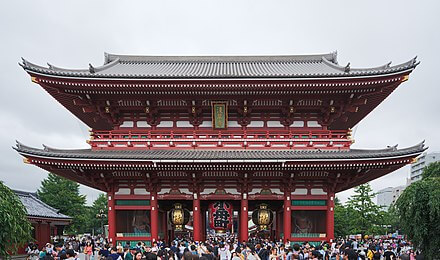
It’s located right next to the Nakamise shopping street, which is centuries old and has a variety of fun stalls and restaurants selling everything from jewelry to folding fans.
If you’re in Tokyo, I highly recommend exploring Sensōji Temple and its surrounding shopping street – it’s a fantastic place to find souvenirs, take great pictures, and experience an ancient temple right in the middle of Tokyo!
Tokyo Temples
Meiji Jingu Shrine // 明治神宮
As you might guess from the name of this shrine, it’s pretty recent, dating from the end of the Meiji period (1912). Located in the outskirts of Shibuya, in 170 acres of forest, this shrine is dedicated to the enshrined spirits of Emperor Meiji and Empress Shōken.

The shrine is roughly a 10-minute walk from the entrance to the forest, which is also used for recreational activities.
The Meiji Jingu Shrine itself is large, and has several festivals every year, in addition to wedding ceremonies. When I visited, I saw two wedding processions!
If you want to take a break from the hustle and bustle of Tokyo, visiting this shrine makes for a lovely walk and great picture opportunities.

A Traveller’s Guide to Weather in Japan
The weather in Japan is very easy to plan for, with four distinct seasons but very different climates and temperatures from north to south.
Kyoto Temples
Kinkakuji // 金閣寺
Kyoto is the city of temples and shrines, so if you visit, make it a plan to do as many as you can!
If you only have time for a few, try and make it to at least Kinkakuji, Tōji, and the Fushimi Inari Shrine, which are some of the most famous and gorgeous temples and shrines on this list.
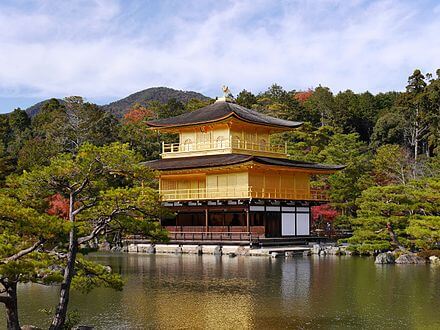
You may recognize Kinkakuji, or the Temple of the Golden Pavilion, from Yukio Mishima’s novel of the same name. However, that’s not all there is to this golden temple. Dating from 1397, it was originally used as a shogun’s villa before being converted into a Zen Buddhist temple.
It’s famous for its lustrous golden exterior and picturesque location next to a lake. As you walk around the lake to see the temple, you can also see the surrounding gardens.
⚠️ But be warned – this is one of the most popular tourist destinations in Kyoto, so expect to wade through large crowds.
Still, the temple’s history and beauty make it worth seeing.
To practice speaking about visiting temples in Japanese, check out our online Flexi Classes platform where you can learn with native speaker teachers today!
Kyoto Temples
Fushimi Inari Shrine // 伏見稲荷大社
While Kinkakuji is certainly popular, the Fushimi Inari Shrine is easily the most well-known of Japan’s temples and shrines, as its seemingly never-ending line of red torii gates has made it an ubiquitous image for travel book and magazine covers about Japan.
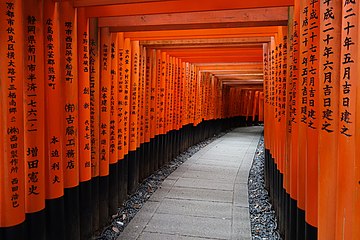
This shrine, built in 711 and dedicated to the kami (god) of rice, agriculture, and business, is absolutely worth the visit. When you go, you follow the 10,000 torii gates up the mountain, using built-in steps. Along the way, there are a couple of checkpoints to rest and buy tea and souvenirs.
Fun fact: Each of the torii gates was dedicated by a different business hoping for good luck!
If you have mobility issues or don’t fancy climbing up the entire way, don’t worry. Before you reach the torii gates, you visit the main buildings of the shrine, with are more easily accessible. If you aren’t up to the stairs, the buildings are also worth seeing.
I highly recommend visiting the Fushimi Inari Shrine – beyond its visual charm, it also feels very Shinto. Its mountainous location makes for a lovely walk through nature, which is one of Shinto’s cornerstones, as it emphasizes one’s connection and respect for nature.
Kyoto Temples
Tōji Temple // 東寺
If you want to see a gorgeous pagoda, Tōji is the temple for you!
Dating from 796, in addition to its pagoda, this UNESCO World Heritage Site has five other buildings with Buddhist treasures.
You can’t take pictures inside the pagoda or the other buildings due to preservation rules, so it’s worth buying the postcards in the gift shop to have something to take home!
Of course, you can take as many pictures as you like of the outside of the buildings.
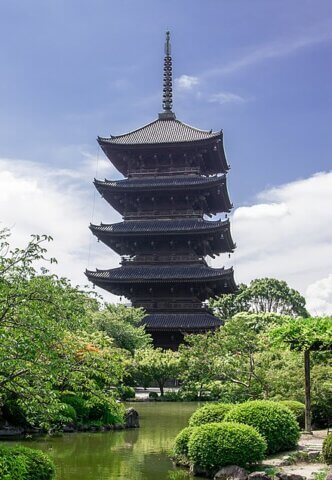
Beyond the architecture, the grounds of the temple are worth a visit, especially the garden, which is a lovely place to sit on a bench and be alone with one’s thoughts for a while.
If you visit on the 21st of the month, you’ll also get to see the monthly flea market, which features pottery, clothes, antiques, and food!
Where’s your favourite temple in Japan? Let us know in the comments!
Kyoto Temples
Sanjūsangen-dō // 三十三間堂
Sanjūsangen-dō, meaning The Temple of 33 Days, is a Buddhist temple best known for its 1,001 statues of the goddess Kannon.
It was founded by the samurai Taira no Kiyomori, who dedicated it to the Emperor in order to get into his good graces.
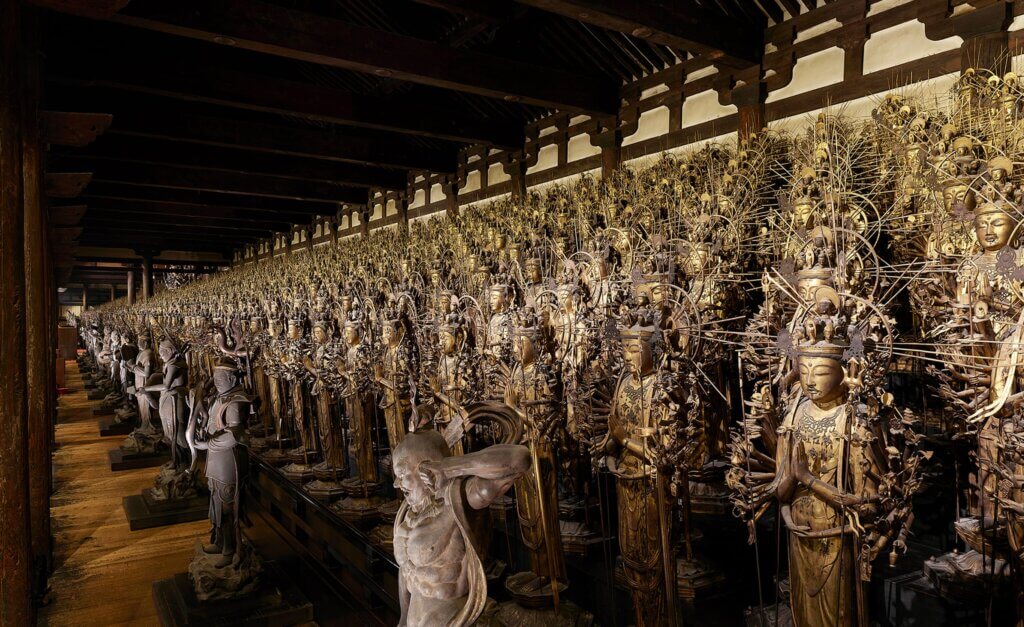
The temple has a small but pretty garden that you’ll see when you walk across the grounds, as well as some buildings that are under restoration.
However, the true draw is the 1,000 life-size statues of the goddess Kannon, the goddess of compassion, which surround the even larger main statue of the thousand-armed Kannon.
The array of statues is truly an impressive sight! Similar to Tōji, pictures of the statues are not allowed, but you can buy postcards of them in the gift shop when leaving.

Only in Japan || 12 Wonderful & Unique Places to Stay in Japan (+ A Bonus Entry)
If you’re looking for unique places to stay in Japan, you won’t be disappointed. Here are the 12 best places to stay in Japan with a bonus option also.
Kyoto Temples
Shinnyodō // 真如堂
Lastly, this is a hidden gem of a temple in Kyoto. It was one of my favorites when I visited!
Located in the outskirts of the city, Shinnyodō is a Buddhist temple established by the monk Kaisan in 984.
It features a pagoda, stately main hall, and a beautiful zen garden.
When I visited, I was surprised to discover a small building across from the zen garden with gorgeous ink paintings (襖絵) on the sliding doors (fusuma) of the traditional Japanese building, called fusuma-e.
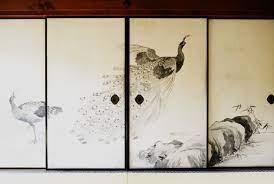

When you visit, you’re meant to sit with the paintings for a while in reflection. Since the temple is located at the top of a tall hill on the outskirts of the city, it’s a quiet and serene place.
If you have time, I recommend visiting Shinnyodō – its serenity, beauty, and impressive grounds are absolutely worth the trek.
Shrines and Temples // Essential Vocabulary
| Japanese | Romanji | English | Association |
|---|---|---|---|
| 神社 | Jinja | Shrine | Shinto Shrines |
| お寺 | Otera | Temple | Buddhist Temples |
| 鳥居 | Torii | Torii gate | Shinto Shrines |
| 二礼二拍手一礼 | Ni Rei Ni Hakushu Ichi Rei | Two bows, one clap, two bows; done when praying at a shrine and offering a coin | Shinto Shrines |
| 手水舎 | Chozuya | Water purification | Both |
| おみくじ | Omikuji | Fortune for the year; see here to learn more | Both |
| お守り | Omamori | Protective amulet; can buy for a variety of functions | Both |
| 絵馬 | Ema | Wooden plaque to write hopes and wishes on | Both |

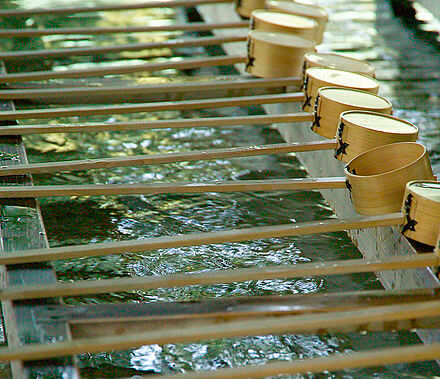
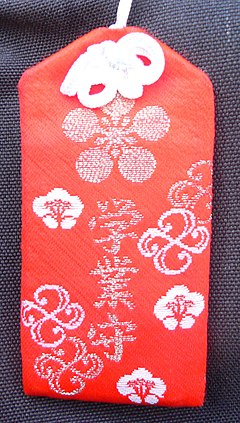

Tokyo and Kyoto Shrines || FAQ’s
What is the difference between a temple and a shrine?
A temple is a Buddhist place of worship. A shrine is a Shinto place of worship.
What is Shinto?
Shinto is a traditional Japanese religion centered around the relationship between people and nature and worshipping the kami, which are the embodiments of nature. Today, many Japanese people still practice the associated rituals, such as worshipping at shrines and buying protective amulets for good luck, better health, or academic success.
What is Buddhism?
Buddhism is a religion which originated in India around 450 BCE. It came to China through the silk road around 100 CE, and to Japan from China around the Nara period, around 700 CE. It centers around the worship of Buddha and his teachings, with the eventual goal of reaching Nirvana (liberation from dissatisfaction/unease). It is the 4th-largest religion in the world.
What’s the best shrine to visit in Tokyo?
I recommend either the Meiji Jingu Shrine or the Ueno Toshogu Shrine.
What’s the best temple to visit in Tokyo?
The best temple to visit in Tokyo is the Sensōji Temple.
What’s the best shrine to visit in Kyoto?
The best shrine to visit in Kyoto is the Fushimi Inari Shrine.
What’s the best temple to visit in Kyoto?
The top 2 temples in Kyoto are Kinkakuji and Tōji Temple.
Where can I learn Japanese before my trip?
You can learn with LTL’s online Flexi Classes, or even while you’re in Japan! We’ll teach you everything you need to know to be a tourist and beyond.
Want More From LTL?
WANT TO LEARN JAPANESE? Check out our online Japanese courses here.
We offer a 7-day free trial to all new students where you can study 24/7.
What about studying Japanese in Japan instead? We’ve got your back. Our Japanese courses in Tokyo can either be taken in small groups of no more than 5 students or individually for a more tailored experience.
We even offer incredible homestay experiences in Tokyo as well.
Come and be a part of this amazing community.








